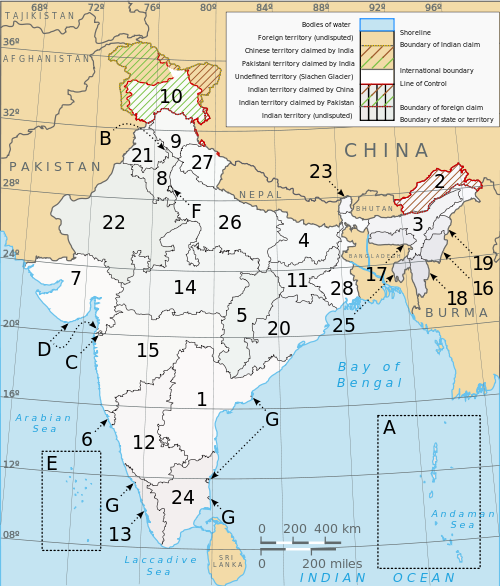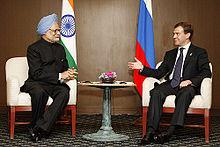
Government
Main article: Government of India
See also: Elections in India

![]()
Rashtrapati Bhavan, home of the President of India.
India is a federation with a parliamentary system governed under the Constitution of India, which serves as the country's supreme legal document. It is a constitutional republic and representative democracy, in which "majority rule is tempered by minority rights protected by law". Federalism in India defines the power distribution between the federal government and the states. The government abides by constitutional checks and balances. The Constitution of India, which came into effect on 26 January 1950,[140] states in its preamble that India is a sovereign, socialist, secular, democratic republic.[141] India's form of government, traditionally described as "quasi-federal" with a strong centre and weak states,[142] has grown increasingly federal since the late 1990s as a result of political, economic, and social changes.[143][144]
|
National symbols[1] |
|
|
Flag |
Tricolour |
|
Emblem |
Sarnath Lion Capital |
|
Anthem |
Jana Gana Mana |
|
Song |
Vande Mataram |
|
Calendar |
Saka |
|
Game |
Hockey |
|
Flower |
Lotus |
|
Fruit |
Mango |
|
Tree |
Banyan |
|
Bird |
Indian Peafowl |
|
Land animal |
Royal Bengal Tiger |
|
Aquatic animal |
River Dolphin |
|
River |
Ganges |
-
Executive: The President of India is the head of state[145] who is elected indirectly by a national electoral college[146] for a five-year term.[147] The Prime Minister of India is the head of government and exercises most executive power.[148] Appointed by the president,[149] the prime minister is by convention supported by the party or political alliance holding the majority of seats in the lower house of parliament.[148] The executive branch of the Indian government consists of the president, the vice-president, and the Council of Ministers—the cabinet being its executive committee—headed by the prime minister. Any minister holding a portfolio must be a member of one of the houses of parliament.[145] In the Indian parliamentary system, the executive is subordinate to the legislature; the prime minister and his council directly responsible to the lower house of the parliament.[150]
-
Legislative: The legislature of India is the bicameral parliament. It operates under a Westminster-style parliamentary system and comprises the upper house called the Rajya Sabha ("Council of States") and the lower called the Lok Sabha ("House of the People").[151] The Rajya Sabha is a permanent body that has 245 members who serve in staggered six-year terms.[152] Most are elected indirectly by the state and territorial legislatures in numbers proportional to their state's share of the national population.[149] All but two of the Lok Sabha's 545 members are directly elected by popular vote; they represent individual constituencies via five-year terms.[153] The remaining two members are nominated by the president from among the Anglo-Indian community, in case the president decides that they are not adequately represented.[154]
-
Judicial: India has a unitary three-tier judiciary, consisting of the Supreme Court, headed by the Chief Justice of India, 21 High Courts, and a large number of trial courts.[155] The Supreme Court has original jurisdiction over cases involving fundamental rights and over disputes between states and the Centre; it has appellate jurisdiction over the High Courts.[156] It is judicially independent[155] and has the power both to declare the law and to strike down union or state laws which contravene the constitution.[157] The Supreme Court is also the ultimate interpreter of the constitution.[158]
Subdivisions
Main article: Administrative divisions of India
See also: Political integration of India
India is a federation composed of 28 states and 7 union territories.[159] All states, as well as the union territories of Pondicherry and the National Capital Territory of Delhi, have elected legislatures and governments, both patterned on the Westminster model. The remaining five union territories are directly ruled by the Centre through appointed administrators. In 1956, under the States Reorganisation Act, states were reorganised on a linguistic basis.[160] Since then, their structure has remained largely unchanged. Each state or union territory is further divided into administrative districts. The districts in turn are further divided into tehsils and ultimately into villages.
States
|
|
|
|
Union territories
|
A clickable map of the 28 states and 7 union territories of India.

![]()
Foreign relations and military
Main articles: Foreign relations of India and Indian Armed Forces

![]()
Manmohan Singh meets Dmitry Medvedev at the 34th G8 summit. India and Russia share extensive economic, defence, and technological ties.
Since its independence in 1947, India has maintained cordial relations with most nations. In the 1950s, it strongly supported decolonisation in Africa and Asia and played a lead role in the Non-Aligned Movement.[161] In the late 1980s, the Indian military twice intervened abroad at the invitation of neighbouring countries: a peace-keeping operation in Sri Lanka between 1987 and 1990; and an armed intervention to prevent a coup d'état attempt in Maldives. India has tense relations with neighbouring Pakistan; the two nations have gone to war four times: in 1947, 1965, 1971, and 1999. Three of these wars were fought over the disputed territory of Kashmir, while the fourth, the 1971 war, followed from India's support for the independence of Bangladesh.[162] After waging the 1962 Sino-Indian War and the 1965 war with Pakistan, India pursued close military and economic ties with the Soviet Union; by the late 1960s, the Soviet Union was its largest arms supplier.[163]
Aside from ongoing strategic relations with Russia, India has wide-ranging defence relations with Israel and France. In recent years, it has played key roles in the South Asian Association for Regional Cooperation and the World Trade Organisation. The nation has provided 100,000 military and police personnel to serve in 35 UN peacekeeping operations across four continents. It is an active participant in various multilateral forums, most notably the East Asia Summit and the G8+5.[164] In the economic sphere, India has close relationships with the developing nations of South America, Asia, and Africa. It pursues a "Look East" policy that seeks strengthened partnerships with the ASEAN nations, Japan, and South Korea revolving around many issues, but especially those involving economic investment and regional security.[165][166]

![]()
The HAL Tejas is a light supersonic fighter developed by the Aeronautical Development Agency and manufactured by Hindustan Aeronautics in Bangalore.[167]
China's nuclear test of 1964, as well as its repeated threats to intervene in support of Pakistan in the 1965 war, convinced India to develop nuclear weapons.[168] India conducted its first nuclear weapons test in 1974 and carried out further underground testing in 1998. Despite criticism and military sanctions, India has signed neither the Comprehensive Nuclear-Test-Ban Treaty (CTBT) nor the Nuclear Non-Proliferation Treaty, considering both to be flawed and discriminatory.[169] India maintains a "no first use" nuclear policy and is developing a nuclear triad capability as a part of its "minimum credible deterrence" doctrine.[170][171] It is also developing a ballistic missile defence shield and, in collaboration with Russia, a fifth-generation fighter jet.[172] Other major indigenous military development projects include Vikrant-class aircraft carriers and Arihant-class nuclear submarines.[172]
Since the end of the Cold War, India has increased its economic, strategic, and military cooperation with the United States and the European Union.[173] In 2008, a civilian nuclear agreement was signed between India and the United States. Although India possessed nuclear weapons at the time and was not party to the Nuclear Non-Proliferation Treaty (NPT), it received waivers from the International Atomic Energy Agency and the Nuclear Suppliers Group (NSG), ending earlier restrictions on India's nuclear technology and commerce. As a consequence, India has become the world's sixth de facto nuclear weapons state.[174] Following the NSG waiver, India was also able to sign civilian nuclear energy cooperation agreements with other nations, including Russia,[175] France,[176] the United Kingdom,[177] and Canada.[178]
The President of India is the supreme commander of the nation's armed forces. With 1.6 million active troops, the Indian military is the world's third-largest.[179] It comprises the Army, the Navy, the Air Force, and auxiliary forces such as the Paramilitary Forces, the Coast Guard, and the Strategic Forces Command.[6] The official Indian defence budget for 2011 was US$36.03 billion, or 1.83% of GDP.[180] According to a 2008 SIPRI report, India's annual military expenditure in terms of purchasing power stood at US$72.7 billion,[181] In 2011, the annual defence budget increased by 11.6%,[182] although this does not include funds that reach the military through other branches of government.[183] As of 2012, India is the world's largest arms importer; in the period from 2006 to 2010, it accounted for 9% of money spent on international arms purchases.[184] Much of the military expenditure was focused on defence against Pakistan and countering growing Chinese influence in the Indian Ocean.[182]
Infrastructure
